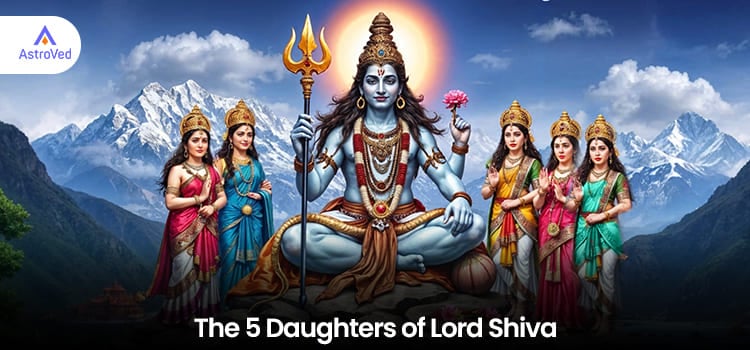The 5 Daughters of Lord Shiva
Shiva is one of the Trimurti or 3 major gods in Hinduism. He is the archetype of destruction. He destroys the world so that it can be created anew. Shiva is quite unlike the other gods, who wear fine clothes and jewelry. He lives in the cremation ground, hangs out with ghouls, and wears tiger skin. His body is smeared with ash, and snakes are his adornments. Quick to anger, he is also a generous and compassionate god who dispenses boons freely, even to those who are likely to misuse them. His consort is Goddess Parvati, and Lord Ganesha and Muruga are their sons.
Parvati is also called Shakti. The union of Shiva and Parvati represents the fusion of masculine and feminine energies, as well as the interplay of creation and destruction. It signifies the harmony of cosmic forces. Parvati perfectly complements Shiva's asceticism with her nurturing qualities.
Shiva’s Daughters
There is a belief that Shiva has 5 daughters, too. They represent various aspects of existence and consciousness. Shiva’s 5 daughters are Jaya, Vishar, Shamlibari, Dev, and Dotli. Each of them has her own place in the cosmic order. They signify different aspects of life, spirituality, and the natural world.
Jaya, the Goddess of Knowledge
Jaya embodies the essence of Saraswati, the Hindu Goddess of Knowledge, wisdom, music, arts, and learning. Saraswati is the patron deity of education and creativity. Her blessings bring enlightenment and intellectual growth. Jaya represents the pursuit of knowledge and the arts. Her grace helps us expand our horizons and gain wisdom.
Vishar, the Goddess of Wealth
Vishar embodies the traits of Lakshmi, the Goddess of Wealth and prosperity. Lakshmi bestows material and spiritual wealth, creating prosperity and contentment. Vishar blesses one with abundance and inspires people to aspire to all forms of wealth.

Shamlibari, the Mother Goddess
Shamlibari embodies the qualities of Goddess Parvati, the Divine Mother. Parvati represents motherly love, compassion, and strength. She nurtures all with her infinite grace. Shamlibari's blessings bring emotional well-being, domestic harmony, and spiritual growth.
Dev, the River Goddess
Shiva’s daughter, Dev, reflects the traits of Ganga, the sacred river. She signifies purity, cleansing, and rejuvenation. Gangajal (Ganges water) can cleanse our sins and purify us. Dev signifies the flow of life and spirituality. Her blessings help us gain a pure heart and mind to succeed in our spiritual journey.
Dotli/Yamuna
Dotli embodies the essence of Yamuna, the holy river. She represents devotion, spirituality, and sanctity. People worship Yamuna for her purity. She helps devotees to boost their spiritual practice and embrace life’s sacredness. Dotli's blessings enable devotees to discover their true selves and gain enlightenment, thereby boosting their connection with the divine. Thus, Shiva’s daughters stand for the many aspects of existence and consciousness. Their grace brings guidance, inspiration, and spiritual progress.
Other Legends Related to Shiva’s Daughters
There are also other legends that offer a different take on Shiva’s daughters. One such legend claims that Shiva’s daughters were the goddesses, Ashokasundari, Jyothi, and Manasa.
Ashokasundari
Ashoka Sundari’s other names are Lavanya, Anvi, Bala Tripura Sundari, and Viraja.
Ashoka refers to the alleviation of Parvati's sorrow (shoka), while the name Sundari alludes to her beauty. In South India, devotees all her Bala Tripurasundari.
The story goes that Parvati felt lonely and desired a daughter, Ashokasundari, from Kalpavriksha, the wish-fulfilling tree to alleviate her loneliness.
One version of the Nahusha legend claims that Parvati once asked Shiva to take her to see the world's most beautiful garden.
Shiva agreed, and they went to Nandanvana, where she saw the Kalpavriksha tree that could grant one’s desires. After Muruga, her son, left Kailash, Parvati felt sad and lonely.
So, she wanted a daughter from Kalpavriksha, and Ashokasundari was born.
Ashokasundari, Parvati declared, would marry Nahusha of the lunar dynasty one day. Nahusha’s power would rival even Lord Indra’s.
Though her worship is prevalent in Gujarat, there is not much information about Ashokasundari except that she was present when Shiva decapitated Ganesha.
The legend says that she hid behind a salt bag when it happened.
Since then, the goddess has been associated with salt, which represents the flavor of life, without which life is tasteless.
Jyoti
Jyoti is the Hindu goddess of light and the "Vel”. As the goddess of "Vel," she has close links to her brother, Murugan.
There are many legends about the birth of this goddess, who is a daughter of Shiva. The first legend says that she is the personification of Shiva's grace as a child.
While Muruga was born from six sparks emanating from Shiva's forehead, Jyoti was born from a spark from Goddess Parvati's forehead, says the second legend.
Goddess Parvati used her to create the weapon Shakti Vel for Muruga to kill the demon Surapadman.
Devotees believe that Goddess Jyoti is present in the formless or arupa state at the temples dedicated to Muruga. Lord Nataraja, a form of Shiva, is her father. She is the flame that he carries.
During the Moon’s waxing and waning periods, Manonmani (Parvati), Sadashiva (a form of Shiva), and Jyoti dwell in the Ajna chakra in our foreheads, according to Sage Agastya’s words in his poem, Shodasam.
The sage also explains how Jyoti emerged from the Pranava pillar of 'OM.’ Her name is Saravanabhavai, and people worship her Vel form in various Muruga temples.
The name Saravanabhavai indicates her strong bond with Saravana/Muruga. Devotees worship her as Goddess Rayaki, who is associated with the Vedic Raka, in many parts of India. In north India, she is Jwalamukhi.
Manasa
The legend of Manasa is very fascinating. Manasa is the goddess of snakes and a daughter of Shiva.
The Puranas claim that Manasa's mother, the serpent Kadru, conceived her after Shiva touched her.
Manasa is a popular Bengali goddess. She is adorned with snakes, either sitting on a lotus or on another snake.
The heads of 7 cobras form a canopy over her head to shield her from the sun. Sometimes, she holds a baby, who is supposedly her son, Astika.
Manasa is compassionate towards her worshippers and ruthless towards others. Her foul temper is because of her rejection by her father, her husband, and stepmother Parvati.
No image of Manasa is used during her worship. Her images may also be worshipped with symbols like a snake figure, the branch of a tree, or an earthen pot.
People worship her for protection against snake bites and diseases like smallpox and chickenpox.
Manasa has many temples and followers in Bengal. During the monsoon, when snakebites are common, devotees seek the goddess’ intervention.
Manasa is also a fertility deity. People seek her blessings for a good marriage and progeny.
Her other names in Bengal are Neto/Neta, Netidhopani, Netalasundori, etc.
What the Shiva Purana Says
The Shiva Purana also has a legend about Shiva’s daughters.
Parvati and Shiva were once playing about in the water. Their frolicking ended with Shiva ejaculating. He collected his semen on a leaf, and five daughters were born. But they were Nagakanyaas. Shiva knew of their existence, but Parvati didn’t.
Shiva loved his daughters and would often meet them at the lake in the morning. Parvati became curious when he often disappeared in the mornings.
One day, she followed him to the lake. On seeing Shiva with the Nagakanyaas, Parvati became angry. She was about to strike one of the girls with her foot when Shiva told her that the girl was also her daughter, and explained how the girls were born.







